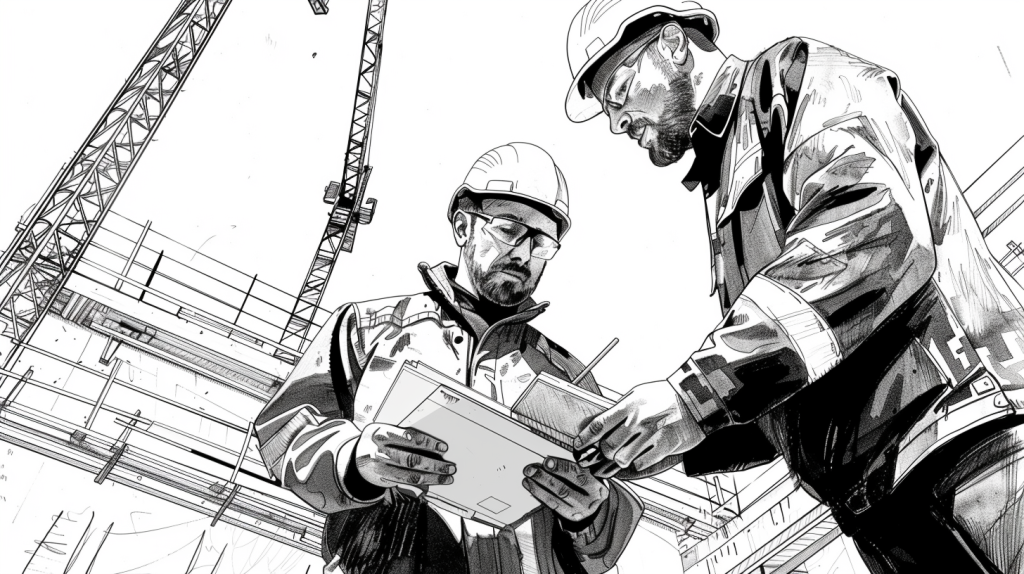The Ultimate Guide to Effective Integration in Construction Management: Top Strategies and Benefits
Table of Contents:

Dive into the ultimate guide to effective integration in construction management. Discover key strategies, tools, and real-world applications that project managers can use to integrate various systems, streamline processes, and achieve successful project outcomes.
In the construction industry, managing multiple projects and coordinating various teams can be challenging. Traditional methods often involve disparate systems and manual data entry, leading to inefficiencies and errors. Effective integration in construction management offers a solution by connecting different tools and systems into a cohesive workflow.
Integration capabilities enable project managers to streamline processes, ensure data consistency, and enhance overall project efficiency. By mastering these capabilities, construction teams can achieve seamless workflows, reduce administrative burdens, and improve communication and collaboration. This guide explores the key strategies, tools, and real-world applications of effective integration in construction management, ensuring that your projects are managed efficiently and successfully.
The Importance of Integration in Construction Management
Enhancing Data Consistency
One of the primary benefits of integrating construction management systems is ensuring data consistency. When different tools and platforms are interconnected, data can flow seamlessly between them, reducing the need for manual data entry and minimizing the risk of errors. This consistency ensures that all team members have access to the most up-to-date information, improving decision-making and project outcomes.
For example, integrating your project management software with your accounting system can automatically update financial records as expenses are logged, ensuring accurate and timely reporting. Similarly, integrating your scheduling tool with your resource management system ensures that any changes in the schedule are immediately reflected in resource allocation.
Streamlining Workflows
Integrations streamline workflows by automating repetitive tasks and reducing the need for manual intervention. By connecting different tools and systems, project managers can create a unified workflow that enhances efficiency and productivity. For instance, integrating a document management system with your project management software allows team members to access and update documents directly within the project management platform.
Streamlining workflows also helps in reducing delays and improving project timelines. Automated notifications and updates ensure that all team members are aware of their tasks and responsibilities, minimizing miscommunications and keeping the project on track.
Improving Communication and Collaboration
Effective communication and collaboration are crucial for the success of construction projects. Integration capabilities facilitate better communication by connecting various tools and platforms used by different teams. For example, integrating instant messaging and collaboration tools with your project management software enables real-time communication and file sharing, fostering collaboration among team members.
Integration also helps in keeping stakeholders informed and engaged. By providing a centralized platform for all project-related information, integrations ensure that stakeholders have access to the latest updates and can provide timely feedback.
Essential Tools for Integration in Construction Management

Project Management Software
Features and Benefits
Project management software provides comprehensive solutions for managing construction projects. These platforms offer features such as task management, document sharing, and real-time communication. Integrating these features with other tools enhances the overall efficiency of the project management process.
Accounting and Financial Management Tools
Streamlining Financial Processes
Integrating accounting and financial management tools with your construction management software helps streamline financial processes. These integrations ensure that all financial data, such as expenses, invoices, and budgets, are automatically updated in real-time, providing accurate and timely financial reporting.
Scheduling and Resource Management Tools
Enhancing Resource Allocation
Scheduling and resource management tools are essential for planning and managing construction projects. Integrating these tools with your project management software ensures that schedules and resource allocations are always up-to-date and accurately reflect project requirements.
Collaboration and Communication Tools
Facilitating Real-Time Communication
Collaboration and communication tools facilitate real-time communication and collaboration among construction teams. These platforms support instant messaging, video calls, and file sharing, making it easy for team members to stay connected and collaborate on tasks. By integrating these tools into their workflows, construction teams can enhance communication and streamline project management.
Best Practices for Mastering Integration Capabilities
Implementing a Unified Platform
Centralizing Project Information
Implementing a unified platform that integrates all project management tools and systems is crucial for achieving seamless workflows. A unified platform ensures that all project information is centralized and easily accessible, reducing the need for multiple logins and manual data entry.
Training and Support
Empowering the Team
Providing training and ongoing support for team members is essential for successful integration implementation. Training sessions should cover the use of integrated tools and systems, ensuring that everyone is comfortable and proficient with the technology. Ongoing support can address any issues or questions that arise, helping to maintain productivity and efficiency.
Ensuring Data Security
Protecting Sensitive Information
Data security is a critical consideration when integrating various tools and systems. Implementing robust security measures, such as encryption, multi-factor authentication, and regular software updates, helps protect sensitive project information. Additionally, educating team members about best practices for data security can prevent breaches and ensure that information remains secure.
Real-World Applications of Integration Capabilities

Financial Reporting and Budgeting
Integrating accounting and financial management tools with your construction management software enhances financial reporting and budgeting processes. For example, integrating QuickBooks with your project management platform allows project managers to track expenses, manage budgets, and generate financial reports directly within the project management platform. This integration ensures accurate and timely financial reporting, helping to keep projects within budget.
Resource Allocation and Scheduling
Integrating scheduling and resource management tools with your project management software improves resource allocation and scheduling processes. For instance, integrating Microsoft Project with your project management platform enables project managers to create and update schedules, allocate resources, and track progress directly within the platform. This integration ensures that schedules and resource allocations are always up-to-date, enhancing overall project efficiency.
Communication and Collaboration
Integrating collaboration and communication tools with your project management software facilitates real-time communication and collaboration among team members. For example, integrating Slack with your project management platform enables team members to communicate, share files, and collaborate on tasks directly within the project management platform. This integration enhances overall project coordination and ensures that all team members are aligned with project goals and progress.
Top 12 Tips for Mastering Integration Capabilities in Construction Management

StruxHub
Experience the power of StruxHub today and witness firsthand how it can revolutionize your construction operations.
1. Choose the Right Tools
Select integration tools and apps that best suit your project’s needs and integrate seamlessly with your existing systems.
2. Implement a Unified Platform
Centralize project information by implementing a unified platform that integrates all project management tools and systems.
3. Provide Training
Offer comprehensive training for team members to ensure they are proficient with integrated tools and understand best practices for their use.
4. Ensure Data Security
Implement robust security measures to protect sensitive project information, including encryption and multi-factor authentication.
5. Automate Repetitive Tasks
Use integrations to automate repetitive tasks, reducing manual intervention and improving efficiency.
6. Monitor Data Consistency
Regularly monitor data consistency across integrated systems to ensure accuracy and reliability.
7. Facilitate Real-Time Communication
Integrate communication tools to enhance real-time communication and collaboration among team members.
8. Streamline Financial Processes
Integrate accounting and financial management tools to streamline financial processes and enhance financial reporting.
9. Enhance Resource Allocation
Integrate scheduling and resource management tools to improve resource allocation and scheduling processes.
10. Conduct Regular Reviews
Regularly review integration usage and its impact on project efficiency, making adjustments as needed.
11. Address Issues Promptly
Use integrated tools to quickly identify and address issues, reducing delays and keeping projects on track.
12. Solicit Feedback
Gather feedback from your team on the integration tools and practices in place, and make improvements based on their input.
StruxHub enhances efficiency and coordination across all project phases, providing a single source of truth that eliminates silos and fosters collaboration. Real-time updates, financial management tools, and seamless communication features ensure that all team members and stakeholders are aligned and informed, reducing the risk of errors and delays. With comprehensive solutions for document management, risk mitigation, and quality control, StruxHub maintains project integrity and safety, while mobile access and integration capabilities further enhance project flexibility and efficiency.
StruxHub’s Key Features and Benefits:
- Advanced Delivery Management: Automate and optimize your delivery schedules, ensuring materials arrive just in time, every time.
- Site Communication: Utilize georeferenced maps and instant messaging to keep every team member informed and aligned.
- Construction Materials Management: Track inventory levels and manage materials procurement with ease, reducing waste and avoiding project delays.
- Construction Safety & Inspection Workflows: Implement customizable mobile forms for conducting safety inspections and managing compliance documentation effortlessly.
- Short-Term Scheduling: Visualize project tasks with detailed floor plans, linking each activity to specific locations for better planning accuracy.
- Construction Resource Management: Efficiently allocate personnel and equipment, maximizing productivity and reducing idle time.
StruxHub’s Product Offering:
- StruxHub Deliveries: Simplifies the coordination of incoming deliveries, ensuring materials and equipment are precisely timed to project needs.
- StruxHub Logistics: Offers intelligent site logistics planning, from crane scheduling to space allocation, for smoother operations.
- StruxHub Safety: Elevates on-site safety standards with easy-to-use tools for inspections, permits, and incident reporting.
- StruxHub Scheduling: Enhances project timelines with intuitive scheduling tools that ensure tasks are completed efficiently and on time.

StruxHub: Revolutionizing Project Management in Large Commercial Construction
FAQ
1. How do integration capabilities enhance construction project management?
Integration capabilities enhance construction project management by connecting various tools and systems into a cohesive workflow. This integration ensures data consistency, reduces manual data entry, and minimizes the risk of errors. By streamlining workflows and automating repetitive tasks, integration improves overall project efficiency. Additionally, integration facilitates better communication and collaboration among team members, ensuring that all project-related information is centralized and easily accessible.
2. What are the key features of effective integration capabilities?
Effective integration capabilities include seamless data synchronization, tool compatibility, and custom workflows. These features ensure that data flows smoothly between different systems, reducing manual data entry and improving data accuracy. Advanced integration solutions also offer robust security features to protect sensitive project information and comprehensive training and support resources to help construction teams master integration capabilities.
3. How can construction teams ensure data security when integrating various tools and systems?
Ensuring data security when integrating various tools and systems involves implementing robust security measures such as encryption, multi-factor authentication, and regular software updates. Encryption protects sensitive information by converting it into unreadable code that can only be accessed with the correct decryption key. Multi-factor authentication adds an extra layer of security by requiring users to verify their identity through multiple methods. Regular software updates help protect against vulnerabilities and keep systems secure. Additionally, educating team members about best practices for data security can prevent breaches and protect project information.
4. What best practices should construction teams follow when implementing integration capabilities?
Best practices for implementing integration capabilities in construction management include choosing the right tools, implementing a unified platform, providing training and support, and ensuring data security. Selecting integration tools and apps that best suit your project’s needs and integrate seamlessly with existing systems is crucial. Implementing a unified platform centralizes project information, enhancing data consistency and streamlining workflows. Comprehensive training for team members ensures they are proficient with integrated tools and understand best practices for their use. Regular reviews of integration usage and its impact on project efficiency, along with gathering feedback from team members, help identify areas for improvement and ensure successful implementation.



